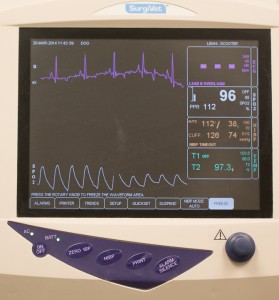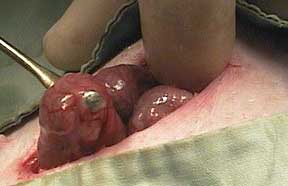Long Beach Animal Hospital offers pot bellied pig spay services for pig owners in Southern CA
Spaying a pig has similarities to spaying dogs and cats, but not a lot! It is an interesting surgery because of the unique anatomy of the pot bellied pig. They have miles of intestines and a uterus that’s very long because of the large number of piglets that are born at one time.
Graphic surgery photos on this page.
On the day of surgery we need your pet in the hospital between 7:30 AM and 9 AM. Please take away all food and water when you go to bed the evening before surgery, and do not give your pig anything to eat or drink the morning of surgery. It will go home in the late afternoon the day of surgery. Please call our office at 4 PM for pickup time, you will be given post operative instructions then.
This is Elly, a young lady who will be our patient today.
Anesthesia
Pre-anesthetic preparation is important in every surgery we perform, no matter how routine, because surgery is not an area to cut corners. All of our spays receive a physical exam prior to surgery. Only if they pass this exam will we draw a small amount of blood for an in-hospital pre-anesthetic test. When everything is to our satisfaction we will administer a sedative. This will calm the pet down and make the administration of the actual anesthetic, along with post operative recovery, much smoother.
Once a pet is anesthetized, prepared for surgery, and had its monitoring equipment hooked up and reading accurately, the surgery can begin.
Pigs need to be monitored carefully for overheating during anesthesia, which is the opposite of most anesthetized animals. They produce more body heat relative to other animals because of their large muscle mass. Pigs do not sweat or pant, they need to be in contact with something cool to rid of excess body heat. Because of this we constantly monitor their temperature during and after the surgery.
We keep a close tab on important physiologic parameters for all of our surgeries. Monitors like this give us an early warning of an impending problem.
Surgery
The following area contains graphic pictures of an actual surgical procedure performed at the hospital. It may not be suitable for some children (and some adults also!).
Every major surgery we perform begins with proper patient preparation. This will help prevent infection, which could be a serious complication in this surgery because during a spay we have an opening into the abdomen.
The surgeon makes an incision near the umbilicus and extends it 3-5 inches in the direction of the tail (the tail is at the left in this picture). We try to make our incisions as small as possible to minimize anesthetic time, decrease post operative discomfort, and minimize the healing time.
Our surgeon is using a #10 blade to start the incision
The tissue just underneath the skin is called the subcutaneous layer. It consists mostly of small blood vessels, and of course fat (this is a pig after all).
The final layer we need to cut before we are actually into the abdomen is called the linea alba. It is an area of muscle in the center of the abdomen that is covered by a tough layer of tissue. This is the most important layer resutured at the end of the surgery because it is the only layer strong enough to hold the abdominal muscles together to prevent a hernia.
In this picture the linea is being held up with a forceps, and a scalpel blade (held upside down) is being used to make the incision.
Scissors are commonly used to extend the linea incision and facilitate the removal of the uterus. Care has to be taken not to puncture internal organs like the bladder.
The scissors is sharp and all we have to do is slide it along the tissue for a proper cut
Buried within the abdominal organs and abdominal fat is the uterus. A special instrument called a spay hook is sometimes utilized to gently pull one of the uterine horns through the abdominal incision.
This hook allows us to keep the skin incision small
The uterine horn is traced into the body cavity until the ovary is found. It has to be gently teased from its location near the kidneys in order to be able to pull it out through the abdominal incision. In older pigs this part of the procedure is much more difficult.
This ovary (arrow) has several follices forming, which is the bumpy appearance.
The blood supply to the ovary is extensive, so a special technique is utilized to prevent hemorrhage. This technique involves the use of special clamps. The smaller arrow on the top points to the ovary, which will be removed along with the clamp. The 2 larger arrows on the bottom point to two sutures used to tie off (called ligation) the blood supply to the ovary.
This area is called the pedicle, and will be replaced back into the abdomen when the surgery is complete.
When both ovaries have been removed the body of the uterus is now ligated.
You can see the first suture being placed at the top of the screen.
Another ligature is placed around the body and the uterus is cut away
The linea alba is now securely resutured. Stainless steel sutures are sometimes used because they are very strong, cause minimal tissue reaction, and show up vividly on an x-ray of the abdomen .
The subcutaneous layer is now closed with a type of suture that dissolves over several months.
The last layer sutured is the skin. Sometimes we put the sutures on the outside, which means they have to be removed in 7-10 days. We call this a bikini scar.
It is at this point that we will give a pain injection, which might make this pig groggy for the evening.
Postoperative Care
Most pigs go home late in the afternoon on the day we perform the surgery. They might be groggy from the pain injection which is advantageous because they will remain calm and allow the healing process to start immediately. By the following morning the grogginess will have worn off.
When you first get home do not be in a big rush to feed. After 1 hour at home offer a small amount of food and water. If the appetite is good, offer more several hours later. Do not over do the feeding the first night because anesthesia can make them nauseous.
Keep contact with children and other pets to a minimum the first night, and restrict activity for several days to allow the incision to heal. Try not let your pig go outside until healing is complete.
















